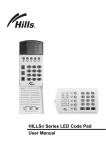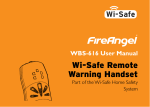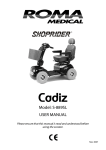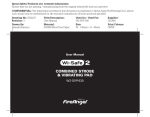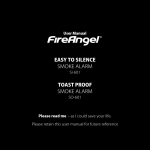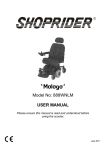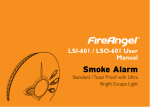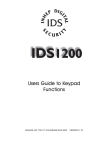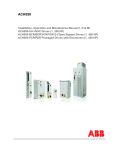Download Wi-Safe Vibrating Alert System
Transcript
N`$JX]\ WVP-626 User Manual Wi-Safe Vibrating Alert System Part of the Wi-Safe Home Safety System ER POW LT FAU RM ALA CONTENTS INTRODUCTION OVERVIEW DEFINITIONS APPLICATION POSITIONING LIMITATIONS HOW TO INSTALL YOUR WI-SAFE VIBRATING ALERT SYSTEM 1 Preparation 2 Connect the rechargeable battery 3 Installation 4 Location of the Vibrating Pad 5 Connecting to Wi-Safe alarms 6 Testing OPERATION 1 2 3 4 5 5 6 10 16 7 Basic Function 8 Removal of AC Mains Power 9 Battery care 10 Battery Replacement 11 System Integrity Check 12 Visual Indicators WHAT TO DO IF YOUR WI-SAFE VIBRATING ALERT SYSTEM ALARMS 21 REPAIR 25 TROUBLESHOOTING 26 DISPOSAL 28 WARRANTY 28 RETURNS 29 PRODUCTS IN THE WI-SAFE RANGE 30 Congratulations! You’ve made a wise investment in an innovative product and your personal safety. The Wi-Safe WVP-626 Vibrating Alert System is one of a new generation of domestic life safety products from FireAngel, which combines the latest technology and innovative design to provide an aesthetically pleasing and effective contribution to your fire and carbon monoxide (CO) safety. Wi-Safe Product Range suitable for use with WVP626 Wi-Safe Vibrating Alert System •Wi-Safe Optical Smoke Alarm WSO-601 •Wi-Safe Ionisation Smoke Alarm WSI-601 •Wi-Safe 10 Year Optical Smoke Alarm WSO610 •Wi-Safe 10 Year Ionisation Smoke Alarm WSI610 •Wi-Safe Carbon Monoxide (CO) Alarm WCO-628 The Wi-Safe Vibrating Alarm System can only be used in conjunction with Wi-Safe smoke and carbon monoxide alarms. The WVP-626 Wi-Safe Vibrating Alert System can be used alongside the WBS-616 Remote Warning Handset. What is Wi-Safe? Wi-Safe is a FireAngel term to describe the wireless, radio frequency (RF) communication signal from the Wi-Safe smoke or CO alarms to the Vibrating Alert System, using the FireAngel unique encryption protocol. The FireAngel range of products is constantly being expanded. Please visit www.fireangel.co.uk to find out about the latest additions to our product range. INTRODUCTION 2 IMPORTANT: This user manual contains important information regarding the operation of your Vibrating Alert System. If you are installing this product for use by others, you must leave this manual (or a copy of it) with the end user. OVERVIEW OF THE FIREANGEL WI-SAFE HOME SAFETY SYSTEM COMPONENTS • Vibrating Pad with Wi-Safe Receiver Box • Remote Warning Handset WBS-616 • Smoke Alarms, WSI-601, WSO-601, WSI-610, WSO-610 • Carbon Monoxide Alarm, WCO-628 • Other future Wi-Safe products ER POW LT FAU RM ALA N`$JX]\ 3 All Wi-Safe products bear the Wi-Safe logo E POW LT FAU RM ALA The FireAngel Wi-Safe Home Safety System consists of a Receiver Box with integral Vibrating Pad to be used in conjunction with FireAngel Wi-Safe smoke or carbon monoxide (CO) alarms. The smoke or CO alarms should be positioned in recommended locations specified in the user manuals accompanying those products. When your smoke or CO alarm triggers, it will go into alarm and will send a radio frequency signal to the Wi-Safe Receiver Box. When the Wi-Safe Receiver Box receives the signal, it will activate the Vibrating Pad and the red LED visual indicator on the Receiver Box will illuminate to indicate what type of signal is being received. The Vibrating Alert System consists of two parts – a Receiver Box with an AC mains adaptor, which plugs into your wall socket, and a Vibrating Pad to be placed under a pillow or on a chair. 0.075A input. DEFINITIONS RF Radio frequency, method of communication LED Light emitting diode (all lights on the Receiver Unit are LEDs) AC Adaptor Alternating current adaptor, plugs into mains supply Encryption Protocol A secure method of communication, isolating alarms within an individual system. The AC mains adaptor is rated at 230V 50Hz 4 APPLICATION POSITIONING WARNING: The Vibrating Alert System is only designed to receive signals from FireAngel Wi-Safe smoke or CO alarms. It will not respond to other models or brands of smoke or fire alarm systems or other FireAngel non Wi-Safe smoke or CO alarms. The FireAngel Wi-Safe Home Safety System is not intended as a substitute for a complete fire alarm system, as specified in BS 5839-6: 2004. WARNING: The Vibrating Alert System will only warn of smoke or carbon monoxide if it receives a signal from a recognised active alarm. Your Wi-Safe smoke or CO alarms communicate to the Wi-Safe Vibrating Alert System (and WiSafe Remote Warning Handset – sold separately) only and will not communicate with each other. In which room should the Vibrating Alert System be installed? The Vibrating Pad should be installed in the primary room where you sleep. Additional Vibrating Alert Systems should be installed in any room where you may need alert in the event of an alarm. Where should the Vibrating Pad be positioned? • Under your pillow • Under cushion on a chair where you are likely to fall asleep Where should the Receiver Box be positioned? • Close to a power socket where it can be easily plugged in and does not create a tripping 5 hazard. • Where it can be secured to a wall or bed post • Where it can be placed on a bedside table (take care not to knock the Receiver Box off table) • Where you can see the LED indicators on the front of the alarm CAUTION: Do not put the Vibrating Alert System • Outside the building • In a cupboard • In a damp or humid area • In an area where the temperature could regularly drop below –5°C or rise above 40°C • where it can easily be knocked or damaged WHAT ARE THE LIMITATIONS? Your Vibrating Alert System requires a FireAngel Wi- Safe smoke or carbon monoxide (CO) alarm to trigger it by radio signal. The Vibrating Alert System will not operate in isolation (on its own), with non Wi- Safe FireAngel smoke or CO alarms or any alarms made by other manufacturers. Your Vibrating Alert System is designed to alert you by vibrating the Vibrating Pad when it receives a signal from an activated smoke or CO alarm. Your Vibrating Alert System may not respond to a signal from a smoke or CO alarm if the alarm and the Receiver Box are too far apart; if there are obstructions that significantly reduce the signal (e.g. steel reinforcement in concrete); or if there are other electrical or electronic equipment that creates interference and obscures the signal. Your Vibrating Alert System will only alert you to the triggering of a smoke or CO alarm if that alarm has been recognised (see ‘Connecting to Wi-Safe Alarms’ on page 12) by your Vibrating 6 Alert System. After initial installation and testing, the performance of the communication between the smoke or CO alarm and your Vibrating Alert System may be compromised by changes in the building’s structure, property or contents. Always test to ensure the entire Wi-Safe Home Safety System (all alarms and receivers) is still working after any changes to your building’s structure, wiring, plumbing, heating or changes in position of major items of furniture (beds, sofas, shelving units, etc.) We recommend that, as a minimum, you install a Vibrating Pad under each pillow you are likely to fall asleep on or under a cushion on a seat that you spend a lot of time on or are likely to fall asleep on. Each Vibrating Alert System works independently of all others and must be programmed individually to receive signals from all Wi-Safe alarms. The Vibrating Alert System will not respond and alert you of a smoke or fire situation without the triggering of a correctly programmed and operational FireAngel Wi-Safe smoke alarm. Also 7 it will not respond and alert you that a high Level of carbon monoxide (CO) has been detected without the triggering of a correctly programmed and operational FireAngel Wi-Safe CO alarm. The FireAngel Wi-Safe Home Safety System may not alarm before a fire causes damage, injury or death, as the smoke may not reach the smoke alarm in time. Examples include smoking in bed and violent gas explosions. The smoke alarm may not respond in a reasonable time if it is not installed in the best position or if obstacles, such as furniture or closed doors, are located between the smoke alarm and the fire. The Wi-Safe Home Safety System may not alarm before a dangerous CO level causes illness, poisoning or death, as the CO may not reach the CO alarm in time. The CO alarm may not respond in a reasonable time if it is not installed in the best position or if obstacles, such as closed doors, are located between the CO alarm and the source of CO. The Vibrating Alert System requires both a continuously powered AC electrical supply and internal battery for its normal operation. The battery accompanying this product is rechargeable and charges when there is mains power to the Receiver Box. WARNING: Use only the battery included in this pack as it has been chosen specifically for this application. Use of other batteries may damage the product. The battery provided is rechargeable and is continuously charged when plugged into the mains. Installation of a non-rechargeable battery is dangerous and may cause harm or damage. If the electrical supply fails or is removed, the unit will continue to operate on its back-up battery for up to 3 days.The yellow LED will flash twice every 5 seconds in the event of a low battery condition. WHEN THIS OCCURS YOU MUST RESTORE POWER WITHIN 3 DAYS TO RECHARGE THE BACKUP BATTERY AND MAINTAIN CORRECT OPERATION. The Vibrating Alert System is designed to alert you with a combination of a Vibrating Pad and visual indication. Heavy sleepers and residents under the influence of alcohol or drugs may not feel the Vibrating Pad. Make sure the Vibrating Pad is placed securely under the pillow/cushion so that it cannot slip underneath the bed or chair meaning it may not alert the person relying on it. Test and check that you can feel the Vibrating Pad in all circumstances where you may find yourself asleep. The Vibrating Alert System employs the latest technology and is independently tested as being compliant with the applicable clauses of relevant British and European Standards. However, as with any electronic product, it might fail and may not produce an indication of smoke or CO within 8 sufficient time to alert you of the danger and provide adequate time for your escape. In order to maximise your level of safety, always test your Vibrating Alert System by testing all alarms in the Wi-Safe system every week to ensure the whole system is in full working order and that the radio frequency (RF) link between the alarms and receivers has not been compromised. (See “Testing” on page 14). NOTE: The Vibrating Alert System, smoke and CO alarms should not be considered as a substitute for life or property insurance. The Vibrating Alert System should be replaced immediately in the event of failure, and replaced every 5 years regardless. CAUTION: Your Receiver Box and Vibrating Pad are sealed AC electrical devices, and no attempt should be made to open the main casing. Attempting to open the main case will: • Damage your system • Possibly result in exposure to a potentially 9 lethal electric shock • Impair its operation • Invalidate your warranty DANGER: Under no circumstances should this product be immersed in water, or used in the presence of water. WARNING: The Vibrating Alert System is intended for operation only on 230V AC, 50 Hz circuits. HOW TO INSTALL YOUR VIBRATING ALERT SYSTEM 1 Preparation IMPORTANT: Make sure you have read and understood this entire manual before installing your Vibrating Alert System. Ensure that all smoke alarms and carbon monoxide (CO) alarms to be used are compatible with your Vibrating Alert System, look for the Wi-Safe symbol (see “Application”, 5). All smoke alarms and CO alarms must be installed, tested and working correctly as per the instructions in their respective user manuals. 2 Connect the Rechargeable Battery WARNING: Connect battery with mains power disconnected. Remove clear protective wrapper or insulation tape from battery terminals prior to installation. Remove the battery cover from the back of the Receiver Box. Press arrow on drawer in and slide out to reveal battery compartment Locate the battery clip and connect the battery by aligning the terminals correctly and clip into place. Place the battery into the Receiver Box and replace the battery cover. When the battery is connected the red and yellow LEDs will illuminate for a short period. At this point 10 the yellow LED will do one of the following: 3 Installation i) If the battery has discharged completely during shipping the yellow LED will flash twice every 5 seconds to indicate that the battery level is low. Depending upon the level of charge in the battery this could continue for up to 72 hours. ii) If the battery has retained sufficient charge during shipping then the yellow LED will flash once every 5 seconds until AC power is connected. We recommend wall mounting the Receiver Box. To do this drill two holes 64mm apart, centre to centre, using the guide below (Warning - make sure that you check for electrical cabling hidden in the wall before carrying out any drilling). In the pack you will find two screws and two screw anchors. Push the screw anchors into the drill holes and secure the screw leaving the heads protruding so that the face of the head is 5mm away from the wall. Now hook the Receiver Box onto the screws (see opposite). If placing the box on a bedside table instead of mounting on the wall, make sure it cannot be easily knocked or slide off. Plug the wall adaptor into a 230V AC supply and ensure the supply is switched on. The green ‘Power’ LED should illuminate continuously to show that the AC power supply is connected. The battery is meant to provide power to the Vibrating Pad in the event that the mains power has been disconnected or has failed. Only this battery should be used.The battery should remain operational for the lifetime of the product ie. 5 years. 64mm 11 4 Location of the Vibrating Pad 5 Connecting to Wi-Safe Alarms Position the Vibrating Pad in its required position. Your Vibrating Alert System is designed to respond to smoke and carbon monoxide alarms that have a Wi-Safe interconnect function. The Vibrating Alert System will only respond to alarms that it has been set up to recognise. This prevents components in your Wi-Safe Home Safety System interfering with other Wi-Safe systems in properties nearby and other wireless products using RF technology near your home. Hook the Receiver Box onto the screws POWER FAULT ALARM The Vibrating Alert System must have been set up in accordance with points 1 ‘Preparation’, 2 ‘Connecting the battery and 3 ’Installation’ before carrying out this procedure. Connecting Wi-Safe Smoke Alarms and Carbon Monoxide Alarms to the Vibrating Alert System Recommendations • Under a pillow where you sleep • Under a cushion where you sit You will need two people to carry out this operation. Using a very small screwdriver or paper clip that 12 has been opened out, push the learn button located in the hole on the side of the Receiver Box briefly and release. On releasing the button the Yellow and Red LEDs on the front of the Handset will illuminate one after the other rapidly continuously (the green light will be permanently illuminated as the mains PO W FA ER ULT AL AR M will be switched on), this shall be referred to as the ‘learn mode LED sequence’. This LED sequence will continue until either the learn mode times out (which happens if no alarms are connected to it for around 4 minutes) or until the learn button is 13 pressed again, which will switch off learn mode. The learn mode LED sequence shows that your Vibrating Alert System is waiting for alarm signals to be learnt. At this point one person should go to the smoke or carbon monoxide alarm that is to be connected and press the test button on that smoke alarm or carbon monoxide alarm. When a smoke alarm is testing the Red LED on the smoke alarm will flash rapidly and the alarm will sound. While the alarm is completing the test procedure, the person monitoring the Receiver Box should notice that the red and yellow LEDs will flash more slowly. NOTE: During the learning process the Vibrating Pad will not activate. Details of the operational test for the Vibrating Pad are included under section 6 ‘Testing’. The change in LED pattern on the Receiver Box indicates that it has recognised the smoke alarm. After a few seconds the LEDs will revert back to the ‘learn mode LED sequence’. When the smoke alarm test cycle is complete the yellow and red LEDs on the Receiver Box will flash rapidly again in the normal ‘learn mode LED sequence’. The person who pushed the test button on the smoke alarm should then return to where the Receiver Box is located and confirm with the person monitoring the Receiver Box that the LED sequence had slowed during the smoke alarm test indicating that it had recognised the smoke alarm. Once confirmed the next alarm can be connected by one person going to the alarm and pressing the test button again while the other person monitors the LEDs on the Receiver Box. NOTE: When connecting CO alarms, only the horn and battery test is required, you do not need to carry out the detailed sensor test. The test button should be held down for 2 seconds only, during which time the LED on the CO alarm will flash Red rapidly and the alarm will sound continuously. After connecting the final smoke/CO alarm in the system, you should press the learn button on the Receiver Box once to stop the learn mode. The ‘learn mode LED sequence’ will stop and only the green LED will remain permanently illuminated (assuming that the AC (mains) power is switched on). This will happen automatically if no alarms are connected for 4 minutes or more. 6 Testing Now the Receiver Box has been connected to all the alarms in the system you should test the functionality of the whole Wi-Safe system. The whole system should also be tested whenever an alarm is added to the system, whenever the Receiver Box is moved, whenever there are changes to the structure of your property or whenever there are significant changes in the position of large items of furniture or electrical products in your home. Testing is simple, but again you will need two 14 people to carry this out. Ensure that your Receiver Box and Vibrating Pad is located in its most suitable position (refer to section on ‘’Positioning’’, page 5), with AC power connected. that the red LED on the Receiver Box flashes for a short time (the time that the CO alarm is in its test cycle i.e. 2 seconds), and that the Vibrating Pad vibrates intermittently. One person will need to go to one of the connected alarms in the Wi-Safe Vibrating Alert System and carry out a self test. Test the alarm as per the user instructions for that particular model. For both alarms the red LED will stop illuminating and the Vibrating Pad will stop vibrating automatically when the alarm signal from the alarm stops, ie. the alarm’s test sequence is complete.The person who has tested the alarm should check with the person monitoring the Receiver Box and Vibrating Pad that the LED on the Receiver Box indicated an alarm and that the Vibrating Pad vibrated while they were away testing the alarm. NOTE: For CO alarms only the horn and battery test is required, you do not need to carry out the in depth sensor test ie. only push the test button on the alarm for 2 seconds. For smoke alarms: The other person should check that the red LED on the Receiver Box illuminates continuously for a short time (the time that the smoke alarm is in its test cycle), and that the Vibrating Pad vibrates. For CO alarms: The other person should check 15 Repeat this procedure for every connected WiSafe alarm. NOTE: The above test procedures should be carried out both with and without the AC power turned on. During tests with AC power off, the yellow LED will also flash once every 5 seconds. OPERATION AOn Standby with AC power connected B In Alarm WCO-628 Smoke Detected CO Detected POWER POWER POWER FAULT FAULT FAULT ALARM ALARM ALARM POWER FAULT ALARM LED status on Receiver Box POWER POWER FAULT FAULT POWER FAULT ALARM ALARM ‘Alarm’ LED indicator on Receiver Box ALARM Vibration warning from Vibrating Pad 16 7 Vibrating Alert System Basic Function AOn Standby with AC power connected The Receiver Box should be connected to an AC supply and the Vibrating Pad should be placed in a suitable position (see positioning on page 5). The green “power” LED on the receiver box will be permanently illuminated. B In Alarm When a Wi-Safe smoke or carbon monoxide alarm goes into “alarm” mode the red LED will illuminate and the Vibrating Pad will vibrate, the way in which the LED illuminates and the way the Pad vibrates depends upon which type of alarm is sending the signal. For smoke alarms: When a signal is detected from a Wi-Safe smoke alarm the red LED will illuminate permanently, and the Vibrating Pad will vibrate for 2 seconds then there will be a 17 2 second pause, this pattern will continue until the smoke alarm stops sending a signal. For CO alarms: When a signal is detected from a Wi-Safe carbon monoxide alarm the red LED will flash 4 times rapidly followed by a short pause, and the Vibrating Pad will vibrate 4 times rapidly followed by a short pause, this pattern will continue until the CO alarm stops sending a signal NOTE: If both smoke and CO alarms go into alarm mode, the red LED and the Vibrating Pad will operate in the same way as it would when receiving a signal from a smoke alarm. The red LED will stop flashing and the Vibrating Pad will stop vibrating when the alarm sending the signal has been reset or has stopped if the danger is no longer present. Only reset an alarm if you are certain there is no imminent danger from Fire or Carbon Monoxide. You will only be able to silence the Vibrating Alert System by silencing the alarm that initially triggered the system. NOTE: The CO alarm can only be silenced if the alarm was caused by low levels of CO being detected ie. less than 50ppm. 8 Removal of AC (Mains) Power If AC (mains) power is removed (through unplugging the wall adaptor, switching off the ac supply or as a result of power outage), the green “power” LED will no longer illuminate continuously, but instead the yellow LED will flash once every 5 seconds. Without AC (mains) power the Receiver Box and Vibrating Pad are powered by its internal backup rechargeable battery. To ensure correct operation the AC (mains) power must be restored as soon as possible. A battery with full capacity will allow the Vibrating Alert System to operate for a total of 3 days. 9 Battery Care The battery must be in good condition to provide adequate backup power in the event that AC (mains) power fails. Under normal operating conditions the backup rechargeable battery will remain servicable for 5 years ie. the lifetime of the product. AC (mains) power should always be connected. If during normal operation the yellow LED flashes twice every 5 seconds while the green LED is illuminated, contact technical support for advice (see page 29). 18 WARNING: Use only the battery included in this packas it has been chosen specifically for this application. Use of other batteries may damage the product. The battery provided is rechargeable and is continuously charged when plugged into the mains. Installation of a non-rechargeable battery is dangerous and may cause harm or damage. 11 System Integrity Check It is important that, when any changes are made to the system or your home, you check that all the elements of the Wi-Safe system are still communicating. When any of the following occur, check the communication between all the alarms in the system and the Vibrating Alert System(s). See Section 6 ‘Testing’ on page 14. •Changing the battery in the Receiver Box 19 •Changing the battery in any alarm in the system •Changing the layout of your house (ie. structural changes, moving large items of furniture, wiring changes, major decorative alterations, adding large metal constructions) •Installation of electronic equipment 12 Visual Indicators NOTE: The Vibrating Alert System depends on correct operation of connected alarms. If a signal is not received from an alarm for any reason (for example, a fault in the alarm or no battery fitted), the Vibrating Alert System will not respond. The Receiver Box will not indicate that there is a fault with alarms in the system. Fault indicators on the Receiver Box relate to faults within the Receiver Box and Vibrating Pad only. Power Green LED permanently illuminated. In normal conditions (AC (mains) power connected), this is continuously illuminated to indicate that the Vibrating Alert System is powered by the AC (mains) power source. If there is no AC (mains) power available or the AC (mains) power has dropped out, been switched off or disconnected, the green LED will not be illuminated and the Yellow Fault LED will flash once every 5 seconds. This indicates that the Vibrating Alert System is powered by the rechargeable backup battery. Learn Mode Green POWER LED. Permanently illuminated Green LED.Yellow and Red LED flashing alternately at rapid frequency. (See “Basic Function” section). Carbon Monoxide Red ALARM LED. Flashing red LED when a Carbon Monoxide alarm in the system is in “alarm” mode. The red LED will flash 4 times rapidly followed by a short pause. (See “Basic Function” section). Low Battery Yellow FAULT LED. Flashes twice every 5 seconds when the internal battery capacity is low - contact Technical Support for advice (see page 29) Other FAULT Conditions Yellow FAULT LED flashes rapidly continuously – internal fault – contact Technical Support for advice (see page 29) Smoke Red ALARM LED. Continuous red LED when a smoke alarm in the system is in “alarm” mode. 20 WHAT TO DO IF YOUR VIBRATING ALERT SYSTEM ALARMS CAUTION: In all circumstances assume your Vibrating Alert System is responding to a real alarm situation that has been triggered by either a smoke alarm or carbon monoxide alarm. a remote signal from a carbon monoxide (CO) alarm the red ALARM LED on the receiver box will flash 4 times rapidly followed by a pause. This cycle will continue while the CO alarm is in alarm. NOTE: If both smoke and CO alarms go into alarm mode, the red LED and the Vibrating Pad will operate in the same way as it would when receiving a signal from a smoke alarm. STAY CALM. PROCEED QUICKLY BUT WITH EXTREME CAUTION – FIRSTLY YOU MUST DETERMINE WHY YOUR WI-SAFE VIBRATING ALERT SYSTEM HAS BEEN TRIGGERED. If the Vibrating Alert System has been triggered by a remote signal from a smoke alarm the red ALARM LED on the Receiver Box will illuminate continuously. If the Vibrating Alert System has been triggered by 21 1 What to do in the Event of a Smoke Alarm Sounding Assume a Fire! What to do in Case of Fire in your Home If you have made a family escape plan and practiced it with your family, you have increased their chances of escaping safely. Go over the following rules with your children each time you have a fire drill. This will help everyone remember them in case of a real emergency. •Don’t panic; stay calm. Your safe escape may depend on thinking clearly and remembering what you have practiced. •Notify every member in the residence of the fire. •Get out of the house as quickly as possible. Follow a planned escape route. Do not stop to collect anything or to get dressed. •Feel the doors to see if they are hot. If they are hot, do not open them - use an alternative escape route. •Stay close to the floor. Smoke and hot gases rise. •Cover your nose and mouth with a cloth (wet if possible). Take short, shallow breaths. •Keep doors and windows closed. Open them only if you have to in order to escape. •Meet at your planned meeting place after leaving the house. Carry out a headcount. •Call the fire service on 999 as soon as possible from outside your house. If possible use a neighbour’s phone or call box rather than a mobile phone (as the location can be traced from the number if the line is lost). •Give the address and your name. •Never go back inside the building until a member of the fire service has told you it is safe to do so. If after proceeding with extreme caution you have been able to confirm that your Vibrating Alert System was triggered by a nuisance alarm which may occur from time to time from cooking or other non emergency situations you should silence the smoke alarm that has been triggered. This will stop the Vibrating Pad from vibrating. It is important to practice escape plans and show everyone in the house, including children, what to do in the event of an alarm. Contact your local fire service. They will give you more ideas about how to make your home safer 22 from fires and how to plan your family’s escape. 2 What to do In the Event of a Carbon Monoxide Alarm Sounding Assume carbon monoxide has been detected in your home! Immediately go to the location of your carbon monoxide detector to determine the level of alarm being indicated. WARNING: An alarm condition indicates that abnormally high and potentially lethal levels of carbon monoxide are present. Never ignore this alarm, further exposure can be fatal. Immediately check residents for symptoms of carbon monoxide (CO) poisoning, and contact the proper authorities to resolve all CO problems. NEVER IGNORE A LOW-LEVEL OR HIGH23 LEVEL ALARM. Ensure that you know what actions to take in the event of both high and low-level alarms. What To Do During A High-Level Alarm • Keep calm and open the doors and windows to ventilate. • Turn off all appliances that are potential sources of CO when possible, and stop using the appliance. These may include gas and wood-burning fireplaces, all gas appliances, and barbecues. • Evacuate the property leaving the doors and windows open. • Ring your gas or other fuel supplier on their emergency number; keep the number in a prominent place. Write your fuel supplier’s emergency number here; • Do not re-enter the property until the alarm has stopped. • Get medical help immediately for anyone suffering the effects of carbon monoxide poisoning, (headache, nausea), and advise that carbon monoxide poisoning is suspected. • Do not use the appliance again until it has been checked by an expert. In the case of gas appliances this must be a CORGI registered installer. • Your alarm will silence when the ventilation has allowed the CO level in your home to drop to an acceptable level. icon by pressing the Test/Reset button. • Do not use the appliance again until it has been checked by an expert. In the case of gas appliances this must be a CORGI registered installer. • Get medical help immediately for anyone suffering the effects of carbon monoxide poisoning (headache, nausea), and advise that carbon monoxide poisoning is suspected. Again, it is important to practice escape plans and show everyone in the house, including children, what to do in the event of an alarm. What To Do During A Low-Level Warning • Open all doors and windows to ventilate. • Turn off all appliances that are potential sources of CO when possible, and stop using the appliance. These may include gas and wood-burning fireplaces, all gas appliances, and barbecues. • Note the reading on the display. • Silence the alarm and turn off the low-level 24 REPAIR DO NOT attempt to repair your Vibrating Alert System. If your Vibrating Alert System is not operating properly, see “Troubleshooting Chart” on pages 26 & 27. If you cannot solve the problem, please call the FireAngel Technical Support Line for advice on 024 7623 6663 or visit the ‘Support’ section on our website www.fireangel.co.uk If your Vibrating Alert System is no longer under warranty, replace it immediately. Your Vibrating Alert System should be replaced after 5 years. CAUTION: The Receiver Box and Vibrating Pad are sealed AC (mains) electrical devices and no attempt should be made to open the main casing. Attempting to open the casings will: •Damage your Vibrating Alert System •Impair its operation 25 •Possibly result in exposure to a potentially lethal electric shock •Invalidate your warranty TROUBLESHOOTING Problem Solution Upon connection of the rechargeable battery the yellow LED flashes twice every 5 seconds This is normal if the battery capacity has become very low in transit. Switch the AC (mains) power on to charge the rechargeable battery. The yellow LED may continue to flash twice every 5 seconds for up to 72 hours (until the battery is sufficiently charged). AC (Mains) Power indicator light is not illuminated Check that the wall adaptor is plugged into an AC (mains) supply securely and the AC (mains) supply is switched on. The Yellow LED is flashing once every 5 seconds This indicates that there is no AC (mains) power to the unit, the green LED will not be illuminated either, restore AC (mains) power to alarm by plugging into socket and making sure that power is switched on. The Yellow LED is flashing rapidly continuously. The Vibrating Alert System has an internal fault, contact Technical Support (see page 29) Cannot press the learn button If using a pen or implement that is too wide, it may not make / cannot instigate learn mode contact with the button in the hole on the side of the Receiver Box. Try using a paper clip that has been opened out or a very thin screwdriver. 26 The Vibrating Alert System does not respond to an alarm that is being tested. Ensure that the smoke/CO alarm is working and does not have a low battery. Check that the alarm is compatible (check for the Wi-Safe logo) and has been connected to the Vibrating Alert System (see “How to Install your Vibrating Alert System - 5 Connecting to Wi-Safe Alarms”, page 12). Move the Receiver Box closer to the alarm and re-test. If it responds, the Receiver Box was positioned too far away from the alarm or something was blocking the signal. See “Positioning”, page 5. While connecting an alarm, the LEDs on the Receiver Box do not change state. Make sure the alarm is Wi-Safe compatible and is working correctly. Ensure the Receiver Box is in its “learn” mode (see “How to Install your Vibrating Alert System - 5 Connect to Wi-Safe Alarms” page 12). The alarm may already be recognised by the Vibrating Alert System. End the learn mode by pushing the learn button once again (the red and yellow LEDs should stop flashing). Now test the alarm, if the Vibrating Pad responds, then the connection has already been made. 27 DISPOSAL Waste electrical products should not be disposed of with regular household waste. Please recycle where facilities exist. Check with your local authority, retailer or manufacturer for recycling/ disposal advice as regional variations apply. The battery should be disconnected before disposal. You can also return your Vibrating Alert System for disposal. For return address see the section on Returns. Please include a note confirming the product is being returned for disposal. WARNING: DO NOT ATTEMPT TO OPEN. DO NOT BURN. 5 YEAR LIMITED WARRANTY INFORMATION Warranty Coverage FireAngel Ltd warrants to the original purchaser that its enclosed Wi-Safe Vibrating Alert System WVP-626 be free from defects in materials and workmanship under normal residential use and service for a period of 5 (five) years from the date of purchase. Provided it is returned with postage prepaid and proof of purchase date, FireAngel Ltd hereby warrants that during the 5 (five) year period commencing from the date of purchase FireAngel Ltd, at its discretion, agrees to replace the unit free of charge. The warranty on any replacement Wi-Safe Vibrating Alert System, will last for the remainder of the period of the original warranty in respect of the alarm originally purchased – that is from the date of original purchase and not from the date of receipt of the replacement product. FireAngel Ltd reserves the right to offer an alternative product similar to that being replaced if the original model is no longer 28 available or in stock. This warranty applies to the original retail purchaser from the date of original retail purchase and is not transferable. Proof of purchase is required. Warranty Disclaimers This warranty does not cover damage resulting from accident, misuse, disassembly, abuse or lack of reasonable care of the product, or applications not in accordance with the user manual. It does not cover events and conditions outside of FireAngel Ltds control, such as Acts of God (fire, severe weather etc). It does not apply to retail stores, service centres or any distributors or agents. FireAngel Ltd. will not recognise any changes to this warranty by third parties. FireAngel Ltd. shall not be liable for any incidental or consequential damages caused by the breach of any express or implied warranty. Except to the extent prohibited by applicable law, any implied warranty of merchantability or fitness for a particular purpose is limited in duration for 5 (five) years. This warranty does not affect your statutory rights. 29 Except for death or personal injury, FireAngel shall not be liable for any loss of use, damage, cost or expense relating to this product or for any indirect or consequential loss, damages or costs incurred by you or any other user of this product. RETURNS We recommend that you contact the FireAngel Technical Support Line in the first instance on 024 7623 6663, text phone users dial 18001 024 7623 6663 or callers from Eire dial 1-800 523171. Alternatively e-mail: [email protected] as we may be able to remedy the problem quickly over the phone (this is to prevent unnecessary returns that take a longer time to process). If there is a fault that we are unable to resolve then our technical support engineer will issue you with a returns authority number so that your product can be returned for testing. To return your Vibrating Alert System under warranty, send it suitably packed and with battery disconnected with postage prepaid; a note indicating the returns authority number and describing the nature of the difficulty, with proof of date of purchase to: FireAngel Limited The TechnoCentre Puma Way Coventry CV1 2TT England PRODUCTS IN THE WI-SAFE RANGE Wi-Safe Product Range suitable for use with WVP626 Wi-Safe Vibrating Alert System •Wi-Safe Optical Smoke Alarm WSO-601 •Wi-Safe Ionisation Smoke Alarm WSI-601 •Wi-Safe 10 Year Optical Smoke Alarm WSO610 •Wi-Safe 10 Year Ionisation Smoke Alarm WSI610 •Wi-Safe Carbon Monoxide (CO) Alarm WCO-628 The WVP-626 Wi-Safe Vibrating Alert System can be used alongside the WBS-616 Remote Warning Handset. 30 Technical Support Line 024 7623 6663 Text phone users dial 18001 024 7623 6663 Eire dial 1-800 523171 E-mail: [email protected] Web: www.fireangel.co.uk FireAngel Ltd. The Technocentre, Puma Way, Coventry CV1 2TT England GN0068/R2


































